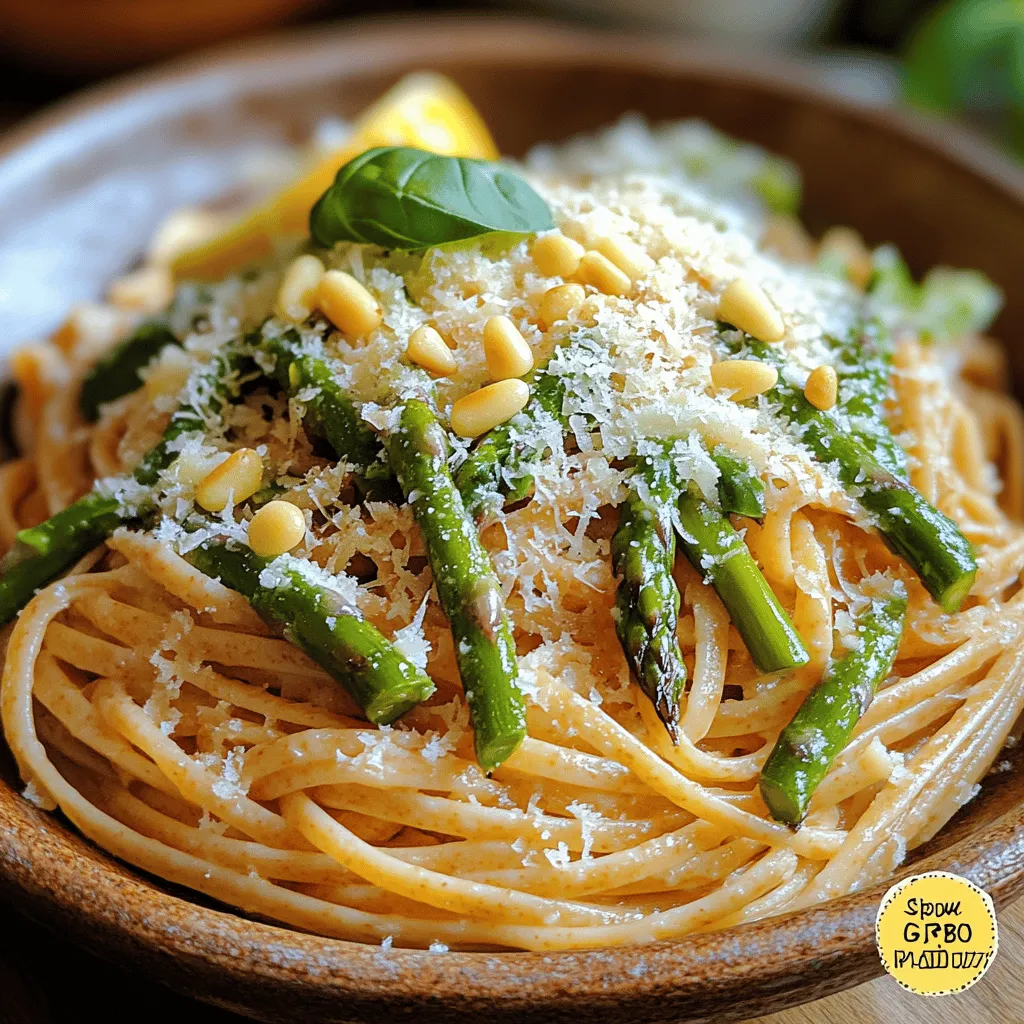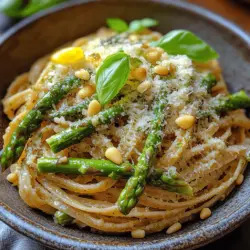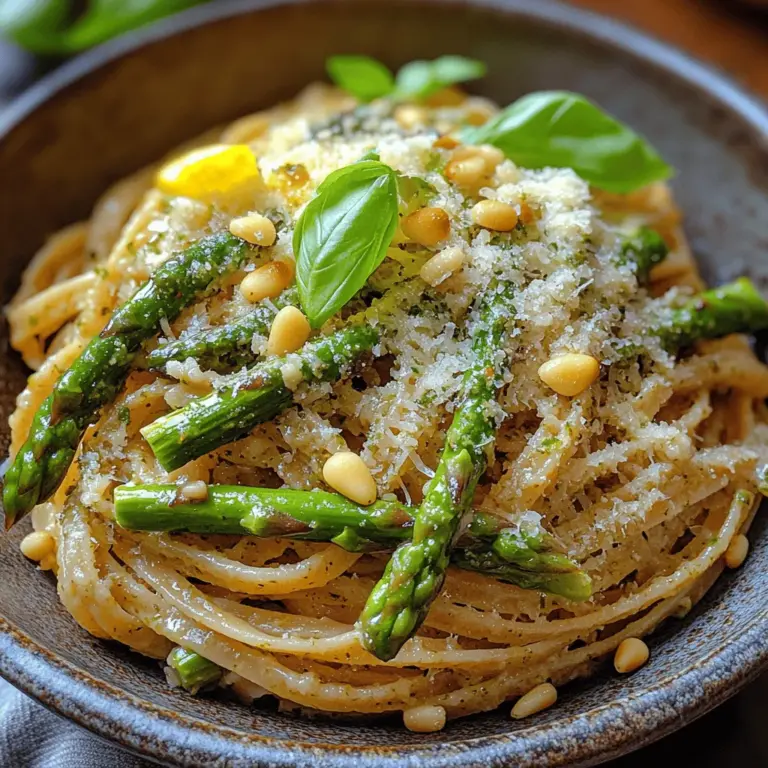Introduction
As the seasons change and spring arrives, so does the opportunity to enjoy lighter, fresher meals that celebrate the vibrant flavors of the season. One dish that perfectly embodies this spirit is the Spring Green Delight Asparagus Pasta. This delightful recipe combines tender asparagus spears with whole wheat pasta, creating a comforting yet health-conscious meal that is as visually appealing as it is delicious. Whether you’re hosting a gathering, preparing a weeknight dinner, or simply craving something nourishing, this asparagus pasta will surely impress.
Asparagus is not just a beautiful addition to any plate; it’s also packed with health benefits. This green vegetable is low in calories yet high in essential nutrients, making it a fantastic choice for those looking to eat healthily. Rich in vitamins A, C, E, and K, asparagus also provides a good amount of fiber, promoting digestive health and aiding in weight management. Paired with whole wheat pasta, this dish takes the nutritional profile up a notch. Whole wheat pasta is a great source of complex carbohydrates, fiber, and essential nutrients, offering a satisfying base that keeps you full longer.
The beauty of this Spring Green Delight Asparagus Pasta lies not only in its health benefits but also in its ease of preparation. With minimal cooking time and a handful of fresh ingredients, you can whip up this gourmet meal in no time. Perfect for a cozy dinner, a festive spring gathering, or even a quick lunch, this dish is versatile and adaptable, making it a staple for any home cook.
Understanding the Ingredients
Whole Wheat Pasta
Whole wheat pasta is the star of this dish, providing a hearty base that complements the fresh asparagus beautifully. Unlike refined pasta, which is stripped of many nutrients during processing, whole wheat pasta retains the bran and germ, resulting in a higher fiber content and a nutty flavor profile. This means not only does it taste great, but it also helps stabilize blood sugar levels and supports digestive health.
When cooking whole wheat pasta, it’s important to follow the package instructions closely, as it tends to cook faster than regular pasta. A helpful tip is to taste it a minute or two before the suggested cooking time to ensure it retains that perfect al dente texture. Additionally, a generous pinch of salt in the boiling water enhances the flavor of the pasta and prevents it from becoming sticky.
Fresh Asparagus
Next up is the star vegetable: asparagus. Known for its unique flavor and impressive health benefits, asparagus is a springtime favorite. This green spear is not only delicious but also a powerhouse of nutrition. It’s loaded with vitamins and minerals, including folate, which is essential for DNA synthesis and repair, as well as potassium, which helps maintain healthy blood pressure levels.
When selecting asparagus, look for firm, bright green stalks with closed tips. Avoid any that appear limp or have a dull color. Fresh asparagus should snap easily when bent, indicating its freshness. Once you bring it home, store it upright in a glass of water in the refrigerator or wrapped in a damp paper towel to maintain its crispness.
Olive Oil and Garlic
No Italian dish is complete without a touch of quality olive oil and the aromatic essence of garlic. Olive oil not only enhances the flavor of the asparagus pasta but also provides numerous health benefits. It’s rich in monounsaturated fats and antioxidants, which can help reduce inflammation and lower the risk of chronic diseases. When choosing olive oil, opt for extra virgin varieties, as they are less processed and packed with flavor.
Garlic is another essential ingredient that brings depth and a distinct aroma to the dish. Besides its delicious flavor, garlic is known for its health benefits, including antibacterial and antiviral properties. For this recipe, fresh garlic is preferable, as it delivers a more robust flavor than pre-minced options. To maximize its taste, sauté the minced garlic lightly in olive oil until fragrant, but be careful not to burn it, as this can impart a bitter taste to the dish.
The Role of Lemon
Lemon plays a crucial role in brightening up the flavors of the Spring Green Delight Asparagus Pasta. The zest and juice of the lemon add a refreshing acidity that balances the richness of the olive oil and cheese. Lemon zest contains essential oils that contribute aromatic qualities, while the juice adds a tangy brightness that enhances the overall flavor profile.
When using lemon, it’s important to differentiate between zest and juice. Zest is the outer yellow layer of the peel, which contains aromatic oils, while the juice provides acidity. For this recipe, both elements are used to create a harmonious flavor balance. To zest a lemon, use a microplane or zester to carefully remove the outer layer without including the bitter white pith underneath.
Parmesan Cheese
Parmesan cheese is a beloved staple in Italian cuisine and adds a savory, umami flavor to the asparagus pasta. When selecting Parmesan, you will encounter various types, from young and mild to aged and robust. For this dish, freshly grated Parmesan is ideal, as it melts beautifully into the pasta and complements the fresh ingredients.
The role of cheese in Italian cooking is not just about flavor; it also adds richness and depth to dishes. Parmesan is particularly beneficial for its protein and calcium content, making it a nutritious addition to your meal. To enhance the flavors further, consider using a mix of Parmigiano-Reggiano for a sharper taste and Grana Padano for a milder flavor.
Fresh Herbs: Basil
To elevate the dish’s freshness, fresh basil is included. This fragrant herb is synonymous with Italian cuisine and adds a burst of flavor and a vibrant green hue to the pasta. Basil is not only delicious but also packed with antioxidants and essential oils that have anti-inflammatory properties.
When chopping basil, it’s best to use a sharp knife to avoid bruising the leaves, which can release bitterness. A simple chiffonade technique, where you stack the leaves, roll them tightly, and slice them into thin ribbons, offers an elegant presentation. To store basil, keep it in a glass of water at room temperature or wrap it in a damp paper towel and place it in the refrigerator to maintain its freshness.
Optional Garnishes: Pine Nuts and Walnuts
For those looking to add an extra layer of flavor and texture, toasted pine nuts or walnuts make excellent optional garnishes. These nuts are not only delicious but also provide healthy fats, protein, and fiber. Pine nuts have a buttery flavor that pairs wonderfully with the asparagus, while walnuts offer a slightly earthy taste.
To toast nuts, simply place them in a dry skillet over medium heat, stirring frequently until they are golden and fragrant. Be careful not to overcook them, as they can burn quickly. Adding toasted nuts as a garnish not only enhances the flavor of the dish but also adds a satisfying crunch that contrasts beautifully with the tender pasta and asparagus.
In summary, the Spring Green Delight Asparagus Pasta is a delightful celebration of spring flavors, combining nutritious ingredients with traditional Italian flair. The mixture of whole wheat pasta, fresh asparagus, aromatic garlic, zesty lemon, and the rich depth of Parmesan cheese creates a dish that is both satisfying and healthy. With its ease of preparation and vibrant flavors, this recipe is perfect for any occasion, inviting you to enjoy the beauty of spring in every bite.

Step-by-Step Guide to Making Spring Green Delight Asparagus Pasta
Cooking the Whole Wheat Pasta
The first step in creating the Spring Green Delight Asparagus Pasta is cooking the whole wheat pasta. Whole wheat pasta is a fantastic choice for a nutritious alternative to traditional pasta, offering more fiber and nutrients.
1. Bring Water to a Boil: In a large pot, fill it with water and bring it to a roaring boil over high heat. Ensure you use plenty of water, as this helps prevent the pasta from sticking together.
2. Importance of Salting the Water: Before adding the pasta, generously salt the boiling water. This is crucial as it enhances the pasta’s flavor. A good rule of thumb is to add about 1-2 tablespoons of salt per gallon of water.
3. Tips for Achieving the Perfect Al Dente Texture: Add the whole wheat pasta to the boiling water and stir it immediately to prevent sticking. Cook according to the package instructions, usually around 8-10 minutes for al dente. To check for doneness, taste a piece of pasta a minute or two before the recommended time. It should be firm to the bite but not hard. Once cooked, reserve about a cup of pasta water and then drain the pasta in a colander.
Blanching Asparagus
While the pasta cooks, it’s time to prep the asparagus. Blanching is an essential technique that preserves the vibrant green color and crisp texture of the asparagus.
1. Importance of Blanching: Blanching involves briefly boiling the asparagus and then shocking it in ice water. This method not only maintains the bright green color but also helps retain the nutrients.
2. Ice Water Bath Technique Explained: In a separate pot, bring water to a boil again. Add the asparagus pieces (cut into 2-inch lengths) to the boiling water for about 2-3 minutes. Once they are bright green and tender-crisp, immediately transfer them to a bowl filled with ice cold water to halt the cooking process. This technique ensures that the asparagus remains fresh and vibrant.
Preparing the Flavorful Sauce
The sauce is where the magic happens, combining the flavors of garlic, olive oil, and fresh herbs to create a delightful coating for the pasta and asparagus.
1. Techniques for Sautéing Garlic Without Burning: In a large skillet, heat 2 tablespoons of extra-virgin olive oil over medium heat. Once hot, add minced garlic (about 2-3 cloves) and sauté for 30 seconds to 1 minute, stirring constantly. Garlic can burn quickly, so keep an eye on it. You want it to become fragrant and lightly golden.
2. Combining Flavors: The Importance of Timing in Adding Ingredients: After the garlic is aromatic, add the blanched asparagus to the skillet. Sauté for another 2-3 minutes, allowing the asparagus to absorb the garlic flavor.
Mixing Pasta with Sauce
Now that your pasta and sauce are ready, it’s time to bring them together for an incredible dish.
1. Importance of Pasta Water in Achieving the Right Consistency: Add the drained whole wheat pasta directly to the skillet with the garlic and asparagus. It’s essential to incorporate some of the reserved pasta water (start with ¼ cup) to help create a silky sauce that clings to the pasta. The starch in the pasta water helps bind the sauce and pasta together.
2. How to Properly Toss Pasta to Ensure Even Coating: Use tongs or a large fork to gently toss the pasta with the sauce, ensuring every strand is coated evenly with the garlic-infused oil. If the mixture appears too dry, add more pasta water, a little at a time, until you achieve the desired consistency.
Finishing Touches
To elevate your Spring Green Delight Asparagus Pasta, you’ll want to finish it off with a few additional touches.
1. Adjusting Flavors with Salt and Pepper: Taste the dish and adjust the flavors with freshly cracked black pepper and more salt, if needed. The balance of seasoning is essential to bring out the vibrant flavors of the asparagus and garlic.
2. How Fresh Herbs Elevate the Dish: Lastly, sprinkle in freshly chopped herbs like basil or parsley just before serving. Fresh herbs add a burst of flavor and color, making your dish visually appealing and appetizing.
Nutritional Analysis of Spring Green Delight Asparagus Pasta
Understanding the nutritional content of your meals is vital for maintaining a balanced diet. Here’s a breakdown of the calories and nutritional content per serving of Spring Green Delight Asparagus Pasta:
– Calories: Approximately 350-400 calories per serving.
– Protein: Around 14g, thanks to the whole wheat pasta.
– Carbohydrates: Approximately 60g, providing energy for your day.
– Fiber: About 8g, which aids digestion and promotes satiety.
– Fats: Roughly 10g, primarily from the olive oil, which contains healthy monounsaturated fats.
Health Benefits of the Dish as a Balanced Meal
Spring Green Delight Asparagus Pasta is not only delicious but also packed with health benefits. The whole wheat pasta offers complex carbohydrates that provide sustained energy, while asparagus is rich in vitamins A, C, E, and K, as well as folate and fiber. This dish is a fantastic way to incorporate more vegetables into your diet while enjoying a satisfying meal.
Comparison with Traditional Pasta Dishes
When compared to traditional pasta dishes, this recipe stands out in terms of healthfulness. Traditional pasta often lacks the fiber and nutrients found in whole wheat varieties. Additionally, the inclusion of vibrant green vegetables like asparagus not only enhances the nutritional profile but also adds flavor and color to your plate.
Serving Suggestions and Pairings
Spring Green Delight Asparagus Pasta is versatile and perfect for various occasions. Here are some suggestions for serving this dish:
Ideal Occasions for Serving This Dish
– Weeknight Dinners: Quick to prepare, this dish is ideal for busy weeknights.
– Spring Gatherings: Celebrate the arrival of spring with a dish that highlights seasonal ingredients.
– Dinner Parties: Impress your guests with this vibrant and flavorful pasta that looks as good as it tastes.
Complementary Side Dishes or Salads
To enhance your dining experience, consider pairing the pasta with:
– A light mixed greens salad drizzled with a lemon vinaigrette.
– Grilled or roasted vegetables for added texture and flavor.
– A refreshing cucumber and tomato salad to contrast the richness of the pasta.
Suitable Wine Pairings for a Complete Dining Experience
To complement the bright flavors of your Spring Green Delight Asparagus Pasta, consider serving it with:
– A crisp Sauvignon Blanc, which pairs beautifully with the green notes of the asparagus.
– A light Pinot Grigio for a refreshing contrast.
– For red wine lovers, a light-bodied Chianti works well without overpowering the dish.
Conclusion
In conclusion, Spring Green Delight Asparagus Pasta is a delightful, healthful dish that celebrates the freshness of seasonal ingredients while providing a balanced meal option. Its vibrant colors, nutritious components, and simple preparation make it a go-to recipe for any occasion.
Not only does this dish offer a unique twist on traditional pasta, but it also encourages creativity in the kitchen by utilizing fresh herbs and vegetables. We encourage you to incorporate seasonal ingredients into your cooking and experience the incredible flavors they bring. Try this recipe today and enjoy the best of what spring has to offer!

